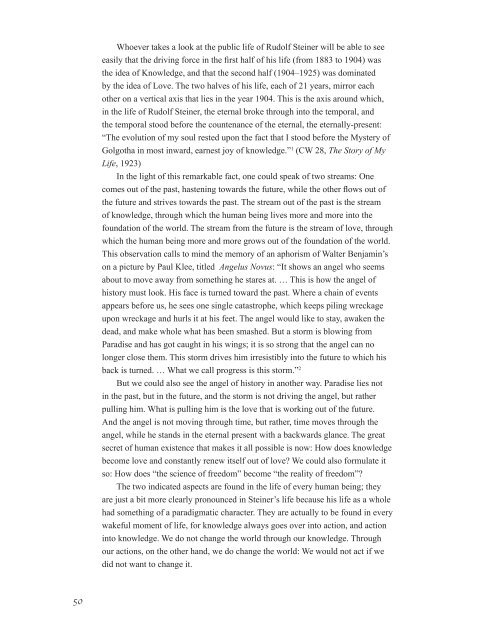Observing the Class Observing the Children - Research Institute for ...
Observing the Class Observing the Children - Research Institute for ...
Observing the Class Observing the Children - Research Institute for ...
You also want an ePaper? Increase the reach of your titles
YUMPU automatically turns print PDFs into web optimized ePapers that Google loves.
50<br />
Whoever takes a look at <strong>the</strong> public life of Rudolf Steiner will be able to see<br />
easily that <strong>the</strong> driving <strong>for</strong>ce in <strong>the</strong> first half of his life (from 1883 to 1904) was<br />
<strong>the</strong> idea of Knowledge, and that <strong>the</strong> second half (1904–1925) was dominated<br />
by <strong>the</strong> idea of Love. The two halves of his life, each of 21 years, mirror each<br />
o<strong>the</strong>r on a vertical axis that lies in <strong>the</strong> year 1904. This is <strong>the</strong> axis around which,<br />
in <strong>the</strong> life of Rudolf Steiner, <strong>the</strong> eternal broke through into <strong>the</strong> temporal, and<br />
<strong>the</strong> temporal stood be<strong>for</strong>e <strong>the</strong> countenance of <strong>the</strong> eternal, <strong>the</strong> eternally-present:<br />
“The evolution of my soul rested upon <strong>the</strong> fact that I stood be<strong>for</strong>e <strong>the</strong> Mystery of<br />
Golgotha in most inward, earnest joy of knowledge.” 1 (CW 28, The Story of My<br />
Life, 1923)<br />
In <strong>the</strong> light of this remarkable fact, one could speak of two streams: One<br />
comes out of <strong>the</strong> past, hastening towards <strong>the</strong> future, while <strong>the</strong> o<strong>the</strong>r flows out of<br />
<strong>the</strong> future and strives towards <strong>the</strong> past. The stream out of <strong>the</strong> past is <strong>the</strong> stream<br />
of knowledge, through which <strong>the</strong> human being lives more and more into <strong>the</strong><br />
foundation of <strong>the</strong> world. The stream from <strong>the</strong> future is <strong>the</strong> stream of love, through<br />
which <strong>the</strong> human being more and more grows out of <strong>the</strong> foundation of <strong>the</strong> world.<br />
This observation calls to mind <strong>the</strong> memory of an aphorism of Walter Benjamin’s<br />
on a picture by Paul Klee, titled Angelus Novus: “It shows an angel who seems<br />
about to move away from something he stares at. … This is how <strong>the</strong> angel of<br />
history must look. His face is turned toward <strong>the</strong> past. Where a chain of events<br />
appears be<strong>for</strong>e us, he sees one single catastrophe, which keeps piling wreckage<br />
upon wreckage and hurls it at his feet. The angel would like to stay, awaken <strong>the</strong><br />
dead, and make whole what has been smashed. But a storm is blowing from<br />
Paradise and has got caught in his wings; it is so strong that <strong>the</strong> angel can no<br />
longer close <strong>the</strong>m. This storm drives him irresistibly into <strong>the</strong> future to which his<br />
back is turned. … What we call progress is this storm.” 2<br />
But we could also see <strong>the</strong> angel of history in ano<strong>the</strong>r way. Paradise lies not<br />
in <strong>the</strong> past, but in <strong>the</strong> future, and <strong>the</strong> storm is not driving <strong>the</strong> angel, but ra<strong>the</strong>r<br />
pulling him. What is pulling him is <strong>the</strong> love that is working out of <strong>the</strong> future.<br />
And <strong>the</strong> angel is not moving through time, but ra<strong>the</strong>r, time moves through <strong>the</strong><br />
angel, while he stands in <strong>the</strong> eternal present with a backwards glance. The great<br />
secret of human existence that makes it all possible is now: How does knowledge<br />
become love and constantly renew itself out of love? We could also <strong>for</strong>mulate it<br />
so: How does “<strong>the</strong> science of freedom” become “<strong>the</strong> reality of freedom”?<br />
The two indicated aspects are found in <strong>the</strong> life of every human being; <strong>the</strong>y<br />
are just a bit more clearly pronounced in Steiner’s life because his life as a whole<br />
had something of a paradigmatic character. They are actually to be found in every<br />
wakeful moment of life, <strong>for</strong> knowledge always goes over into action, and action<br />
into knowledge. We do not change <strong>the</strong> world through our knowledge. Through<br />
our actions, on <strong>the</strong> o<strong>the</strong>r hand, we do change <strong>the</strong> world: We would not act if we<br />
did not want to change it.

















